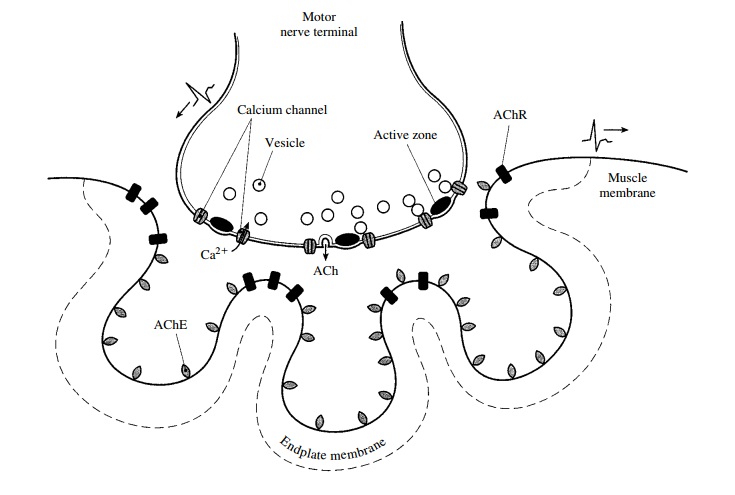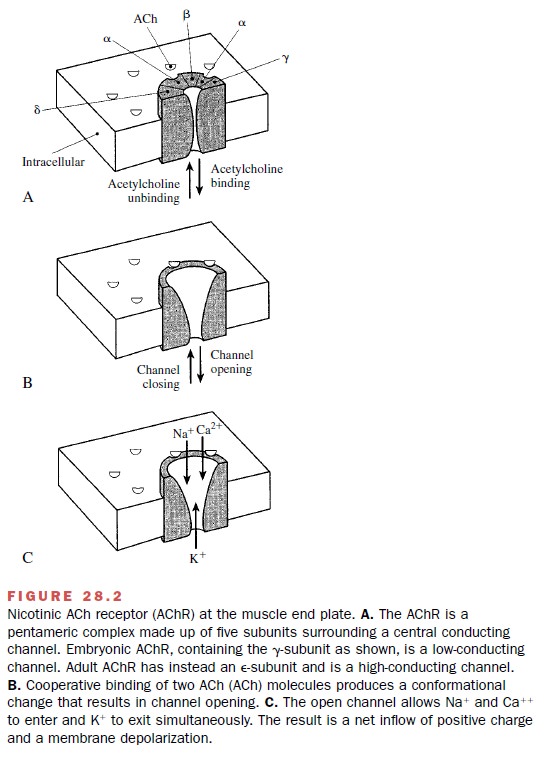Chapter: Modern Pharmacology with Clinical Applications: Local Anesthetics
Agents Affecting Neuromuscular Transmission

Agents
Affecting Neuromuscular Transmission
Neuromuscular transmission
involves the events leading from the liberation of acetylcholine (ACh) at the
motor nerve terminal to the generation of end plate currents (EPCs) at the
postjunctional site. Release of ACh is initiated by membrane depolarization and
influx of Ca++ at the nerve terminal (Fig. 28.1). This leads to a
complex process involving docking and fusion of synap-tic vesicles with active
sites at the presynaptic mem-brane. Because ACh is released by exocytosis,
func-tional transmitter release takes place in a quantal fashion. Each quantum
corresponds to the contents of one synaptic vesicle (about 10,000 ACh
molecules), and about 200 quanta are released with each nerve action potential.
ACh diffusing across the
synaptic cleft may bind to ACh receptors (AChRs) to produce an electrical
re-sponse, interact with acetylcholinesterase (AChE) and be hydrolyzed, or
diffuse into the systemic circulation.
AChRs are located primarily
at the peaks of the subsyn-aptic folds, whereas AChE is distributed uniformly
in the basal lamina at the subsynaptic membrane (Fig. 28.1).
The AChR consists of five
subunits surrounding an ion-conducting channel (Fig. 28.2). Activation of the
binding sites on the two -subunits results in a confor-mational change. This
allows the simultaneous inflow of NA+ and Ca++ and
outflow of K+ , with a net inflow of positive charge. The response
to a spontaneously se-creted quantum of ACh (that is, activation of several
thousand AChRs) is seen as a miniature EPC. With nerve stimulation, many quanta
are released synchro-nously to produce a full-sized EPC, which is the sum-mated
response of the 200 or so individual miniature EPCs. The EPC is a local graded
current that in normal conditions triggers an action potential in the adjacent
muscle membrane (Fig. 28.1).


Drugs may modify transmission by affecting either the release of
transmitter or the interaction of ACh with its receptor. An increase in transmitter
release is pro-duced by substances that induce repetitive firing in the motor
nerve, prolong the nerve action potential, or pro-mote Ca++ influx
at the nerve terminal. An increase in the postjunctional response is produced
by drugs that inhibit AChE (and thereby increase the synaptic con-centration of
ACh), whereas a decrease in response is produced by drugs that block the
binding sites or ion-conducting channel of the AChR.
Changes in miniature EPC frequency,
amplitude, and duration can be used to identify the sites of drug action. In general, a change in frequency indicates
a prejunctional action, while a
change in amplitude re-flects a postjunctional effect. Drugs that inhibit
AChE give rise to a larger and more
prolonged miniature EPC, whereas those that block the AChR binding site produce
a decrease in miniature EPC amplitude. Agents that obstruct the open channel of
the AChR cause a reduction in miniature EPC amplitude and du-ration.
Related Topics